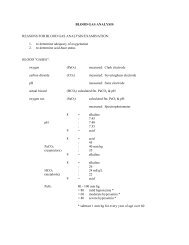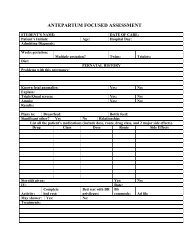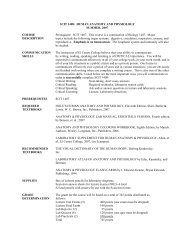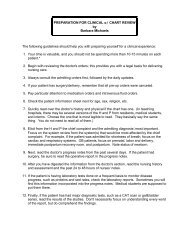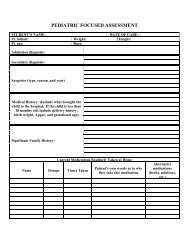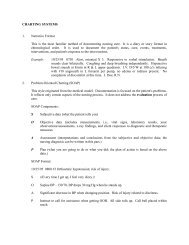Male Reproductive Anatomy References: Lab Manual, Exercise 38, p.
Male Reproductive Anatomy References: Lab Manual, Exercise 38, p.
Male Reproductive Anatomy References: Lab Manual, Exercise 38, p.
You also want an ePaper? Increase the reach of your titles
YUMPU automatically turns print PDFs into web optimized ePapers that Google loves.
1. THE REPRODUCTIVE SYSTEM AND THE MENSTRUAL CYCLE<br />
Station 1: <strong>Male</strong> <strong>Reproductive</strong> <strong>Anatomy</strong><br />
<strong>References</strong>: <strong>Lab</strong> <strong>Manual</strong>, <strong>Exercise</strong> <strong>38</strong>, p. 210-212, complete Fig. <strong>38</strong>.1, p. 211.<br />
Textbook, p. 848-862 and Fig. 22.1, p. 849, Table 22.1, p. 863.<br />
Workbook, p. 277, #1 and #2, p. 278, #3 and #4, p. 280, #5.<br />
Q1A. What structure covers the glans penis but is not on the model <strong>Lab</strong>el it on Fig. 16-1, p. 279 in<br />
your workbook and color it orange.<br />
Q1B. Which two letters identify erectile tissue that engorges with blood during erection Name them.<br />
Color them pink on p. 279 in your workbook.<br />
Q2A. Which letter identifies where sperm mature Name it and color it red on p. 279 in your workbook.<br />
Q2B. Which type of erectile tissue is found in two columns divided by a septum Which letter identifies<br />
it<br />
Q3A. Which letter identifies the accessory structure that produces secretions rich in fructose to provide<br />
energy to the sperm cells for flagellar movement Name it. Color it green on p. 279.<br />
Q3B. Into what duct does the structure in Q3A empty <strong>Lab</strong>el it and color it purple on p. 279.<br />
Q4A. Which letter identifies the male primary sex organ Name it. <strong>Lab</strong>el it on p. 279 in your<br />
workbook.<br />
Q4B. Name two functions of the structure identified in Q4A.<br />
Q5A. Which letter identifies the structure that moves sperm from the scrotum into the pelvic cavity<br />
Name it. Color it yellow on p. 279.<br />
Q5B. Which letter identifies an accessory gland that helps cleanse the urethra for the sperm and<br />
lubricates their path Name it. Color it blue on p. 279.<br />
Q6A. Which letter identifies the accessory structure that can enlarge and interfere with micturition<br />
Name it. Color it pink on p. 279.<br />
Q6B. Which three letters identify structures that contribute to the alkaline fluids that neutralize the<br />
acidity of the vagina<br />
Q7A. Which letter identifies the sac that protects the structure where sperm cells develop Name it.<br />
Q7B. What muscles control the position of the structure in Q7A<br />
Station 2: Female <strong>Reproductive</strong> <strong>Anatomy</strong><br />
<strong>References</strong>: <strong>Lab</strong> <strong>Manual</strong>, p. 212-214 and complete Fig. <strong>38</strong>.3, p. 213, Fig.<br />
<strong>38</strong>.4, p. 213, and Fig. <strong>38</strong>.5, p. 214.<br />
Textbook, p. 865-875, Fig. 22.18, p. 866, Fig. 22.26, p. 872, and<br />
Table 22.2, p.875.<br />
Workbook, p. 283, #10, p. 284, #11 and p. 285, #12.<br />
Q8A. Which letter identifies the innermost layer of the uterine wall Name it. <strong>Lab</strong>el it and color it pink<br />
on p. 284 in your workbook.<br />
Q8B. Which letter identifies the layer of the uterine wall responsible for birth Name it. <strong>Lab</strong>el it and<br />
color it green on p. 284 in your workbook.<br />
Q9A. Which letter identifies the fundus of the uterus Which letter identifies the cervix of the uterus<br />
Q9B. Which letter identifies the infundibulum What are its branched, finger-like projections called<br />
Color these orange on p. 284 of your workbook.<br />
Q10A. Which letter identifies the primary female sex organ Name it. <strong>Lab</strong>el it and color it blue on p.<br />
284.<br />
Q10B. What is the function of the primary female sex organ<br />
Q11A. Which letter identifies the structure that is homologous to the male penis Name it. <strong>Lab</strong>el it and<br />
color it purple on p. 284 of your workbook.<br />
Q11B. Which letter identifies the structure that is homologous to the male scrotum Name it. <strong>Lab</strong>el it<br />
and color it yellow on p. <strong>38</strong>4 of your workbook.<br />
Refer to the diagram on the table and answer these questions:<br />
Q12A. Define PERINEUM.
Q12B. Which letter on the diagram identifies the anus<br />
Q13A. Which letter on the diagram identifies the hymen<br />
Q13B. Which letter on the diagram identifies the urethral orifice<br />
Q14A. Which letter on the diagram identifies the labia majora What color did you color them on Fig.<br />
284<br />
Q14B. Which letter on the diagram identifies the vaginal orifice What is the top of the vagina around<br />
the junction with the uterus called<br />
*Turn in <strong>Lab</strong> Workbook, p. 284 and p. 285 with your lab report.<br />
Station 3: Histology of Sperm Cells<br />
<strong>References</strong>:<br />
Textbook, p. 855 and Fig. 22.9, p.855.<br />
Workbook, p. 282, #7.<br />
Observe the sperm cells in the microviewer:<br />
Q15A. Enzymes responsible for fertilization are found in what structure Color this structure yellow on<br />
Fig. 16.4, p. 282.<br />
Q15B. Which part of the sperm cell uses fructose for energy Color it orange on Fig. 16.4, p. 282.<br />
Station 4: Ovary and Menstrual Cycle<br />
<strong>References</strong>: <strong>Lab</strong> <strong>Manual</strong>, p. 215.<br />
Textbook, p. 877-879, and Table 22.4, p. 880.<br />
Workbook, p. 285, #13, p. 286, #14, p. 287, #16, p. 288, #18, and<br />
#19.<br />
On the model of the ovary:<br />
Q16A. Which letter identifies a maturing follicle Color the maturing follicle pink on Fig. 16.8, p. 289.<br />
Q16B. Name the hormone secreted by the maturing follicle. Color the part of the endometrium that<br />
proliferates under the influence of this hormone yellow on p. 289. <strong>Lab</strong>el the Proliferative Stage.<br />
Q17A. Name the pituitary hormone that stimulates the development of a follicle. Color the line that<br />
represents it green on p. 289.<br />
Q17B. Which letter on the model identifies a follicle in the process of rupturing What is this called<br />
Color it red on p. 289.<br />
Q18A. Name the pituitary hormone that triggers ovulation and stimulates the development of a corpus<br />
luteum from the follicle. Color the line that represents it yellow on p. 289.<br />
Q18B. Which letter identifies the corpus luteum Color the corpus luteum orange on p. 289.<br />
Q19A. Name the hormone secreted by the corpus luteum that stimulates the glandular and vascular<br />
development of the endometrium. Color the part of the endometrium that becomes glandular and<br />
vascular blue on p. 289.<br />
Q19B. Which letter identifies the corpus albicans What structure does the corpus albicans develop<br />
from<br />
Q20A. What event causes menses Color the part of the endometrium representing menses purple on p.<br />
289. When the menses occur, all the hormones are (high/low).<br />
Q20B. The average menstrual cycle lasts -- days. Ovulation occurs at day --.<br />
Q21. CLINICAL APPLICATION THOUGHT QUESTION: (Answer at the bottom of your lab report)<br />
An adolescent male is worried and asks you for advice. Sometimes he wakes up to find that he has<br />
ejaculated during sleep. He wants to know if anything is wrong with him and what he should do. What is<br />
happening to him Why is it happening to him<br />
Turn in p. 279, 282, 284 and 289 with your lab report.





